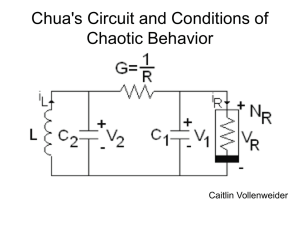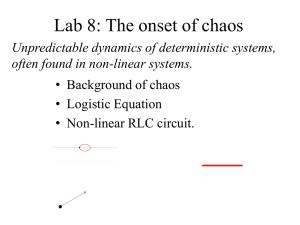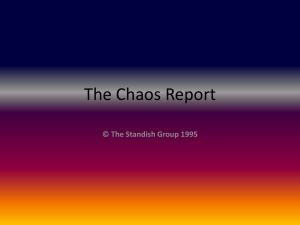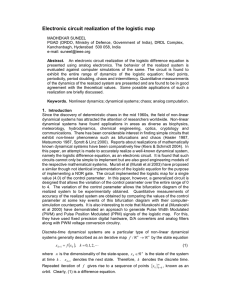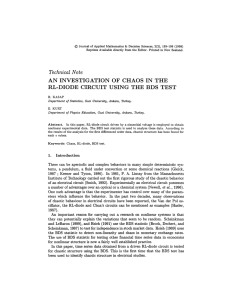Chaos in a Simple Circuit
advertisement
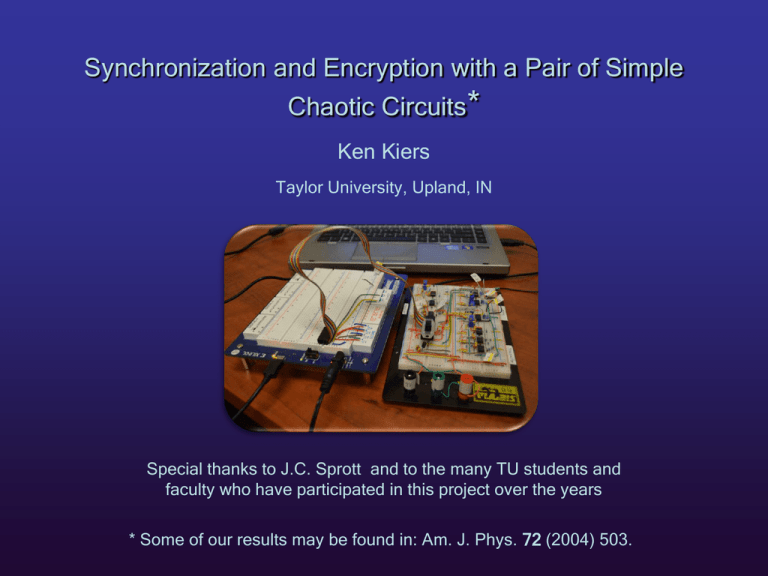
Synchronization and Encryption with a Pair of Simple
Chaotic Circuits*
Ken Kiers
Taylor University, Upland, IN
Special thanks to J.C. Sprott and to the many TU students and
faculty who have participated in this project over the years
* Some of our results may be found in: Am. J. Phys. 72 (2004) 503.
Outline:
1. Introduction
2. Theory
3. Experimental results with a single chaotic circuit
4. Synchronization and encryption
5. Concluding remarks
1. Introduction:
What is chaos?
A chaotic system exhibits extreme sensitivity to initial
conditions…(uncertainties grow exponentially with time).
Examples: the weather (“butterfly effect”), driven
pendulum
What are the minimal requirements for chaos?
For a discrete system…
• system of equations must contain a nonlinearity
For a continuous system…
• differential equation must be at least third order
• …and it must contain a nonlinearity
2. Theory:
Consider the following differential equation:
x Ax x D(x)
(1)
…where the dots are time derivatives, A and are
constants and D(x) is a nonlinear function of x.
For certain nonlinear functions, the solutions are chaotic,
for example:
D( x) | x |,
D( x) 6 min( x, 0)
…it turns out that Eq. (1) can be modeled by a simple
electronic circuit, where x represents the voltage at a node.
→ and the functions D(x) are modeled using diodes
Theory (continued)
…first: consider the “building blocks” of
our circuit….
(inverting) summing
amplifier
V1
Vout
V2
Vout (V1 V2 )
(inverting) integrator
Vout
Vin
Vout
1
Vin dt
RC
alternatively:
dVout
Vin RC
dt
Theory (continued)
The circuit:
R
R
x x x D( x) V0
Rv
R0
→ Rv acts as a control parameter to
bring the circuit in and out of chaos
...the sub-circuit models
the “one-sided absolute
value” function….
experimental data for
D(x)=-6min(x,0)
3. Experimental Results:
digital
potentiometers
analog
chaotic
circuit
A few experimental details*:
• circuit ran at approximately 3 Hz
• digital pots provided 2000-step resolution in Rv
• microcontroller controled digital pots and
measured x and its time derivatives from the
circuit
• A/D at 167 Hz; 12-bit resolution over 0-5 V
• data sent back to the PC via the serial port
* Am. J. Phys. 72 (2004) 503.
PIC
microcontroller
with A/D
personal
computer
Bifurcation Plot → successive maxima of x as a f’n of Rv
chaos (signal
never repeats)
period one
Comparison of
bifurcation points:
period two
period four
Exp.
(k)
Theory
(k)
Diff.
(k)
Diff.
(%)
a
53.2
52.9
0.3
0.6
b
65.0
65.0
0.0
0.0
c
78.8
78.7
0.1
0.1
d
101.7
101.7
0.0
0.0
e
125.2
125.5
-0.3
-0.2
Experimental phase space plots:
experiment and theory
superimposed(!)
x
x
x, x and x are measureddirectlyfrom thecircuit
Power spectrum as a function of frequency
“fundamental” at
approximately 3 Hz
“harmonics” at
integer multiples
of fundamental
period one
period two
“period doubling” is
also “frequency
halving”….
Chaos gives a “noisy”
power spectrum….
period four
chaos
Experimental first- and second-return maps for
successive maxima of a chaotic attractor
return maps show
fractal structure
…sure enough…!
intersections with
diagonal give evidence
for unstable period-one
and –two orbits
Demonstration of chaos….
one bit
; '1'(#2*
<. () $('. & ) () "*
; '1'(#2*<. () $('. & ) () "*
9": - '$. *
! "#$%
&&
'(('(() "* '$*
! "#$%
) "* +'", - '(*
+'", - '(*
. - (*
!/*
• two nearly identical copies of the
same circuit
0- &0-&&
'$1*
& '$1*
+'", - +'",
'(* - '(*
• coupled together in a 4:1 ratio
• second circuit synchronizes to
first (x2 matches x1)
• changes in the first circuit can be
detected in the second through its
inability to synchronize
• use this to encrypt/decrypt data
567! / *8*564! 4
02#3) *
=)-,'(*
) '3) "*
+'",
+'", - '(*
'$*
. - (*
! 4*
Encryption of a digital signal:
changes in RV correspond to
zeros and ones
Encryption of an analog signal
• addition of a small analog signal
to x1 leads to a failure of x2 to
synchronize
• subtraction of x2 from x1+σ yields
a (noisy) approximation to σ
! "#$%&'
C&", #; )$$%&'
( )&*+)$'
( )&*+)$'
6'
), '
7
! 8'
- +$'
. )/, "0'$- '1%'
2, *&34$%5'
! !)9),)9),
/' /'
(*+)$'
)&*+)$'
( )&
! 8': '7
. +; . ;+;), ;/'), /'
( )&*+)$'
( )&*+)$'
>?@A! 8': '7B': '>?=! =
. 0"<%'
D%*%)<%&'
( )&*+)$'
( )&*+)$'
), '
- +$'
! ='
Concluding Remarks
• Chaos provides a fascinating and accessible area of study
for undergraduates
• The “one-sided absolute value” circuit is easy to construct
and provides both qualitative demonstrations and possibilities
for careful comparisons with theory
• Agreement with theory is better than one percent for
bifurcation points and peaks of power spectra for this circuit
• Chaos can also be used as a means of encryption
Extra Slides
xn1 r xn (1 xn )
An Example: The Logistic Map
r=2
r = 3.2
r=4
r=2
r = 3.2
r=4
n
xn
xn
xn
n
xn
xn
xn
0
0.40000
0.40000
0.40000
0
0.35000
0.35000
0.40010
1
0.48000
0.76800
0.96000
1
0.45500
0.72800
0.96008
2
0.49920
0.57016
0.15360
2
0.49595
0.63365
0.15331
3
0.50000
0.78425
0.52003
3
0.49997
0.74284
0.51921
4
0.50000
0.54145
0.99840
4
0.50000
0.61129
0.99852
5
0.50000
0.79450
0.00641
5
0.50000
0.76036
0.00590
6
0.50000
0.52246
0.02547
6
0.50000
0.58307
0.02345
7
0.50000
0.79839
0.09927
7
0.50000
0.77792
0.09160
8
0.50000
0.51509
0.35767
8
0.50000
0.55284
0.33283
9
0.50000
0.79927
0.91897
9
0.50000
0.79107
0.88822
10
0.50000
0.51340
0.29786
10
0.50000
0.52890
0.39715
11
0.50000
0.79943
0.83656
11
0.50000
0.79733
0.95769
12
0.50000
0.51310
0.54692
12
0.50000
0.51711
0.16208
13
0.50000
0.79945
0.99120
13
0.50000
0.79906
0.54324
14
0.50000
0.51305
0.03491
14
0.50000
0.51380
0.99252
15
0.50000
0.79945
0.13476
15
0.50000
0.79939
0.02969
period one
period two
chaos
…the chaotic case is very
sensitive to initial conditions…!
Reference: “Exploring Chaos,” Ed. Nina Hall
Bifurcation Diagram for the Logistic Map
xn1 r xn (1 xn )
r=2
r = 3.2
r=4
n
xn
xn
xn
0
0.40000
0.40000
0.40000
1
0.48000
0.76800
0.96000
2
0.49920
0.57016
0.15360
3
0.50000
0.78425
0.52003
4
0.50000
0.54145
0.99840
5
0.50000
0.79450
0.00641
6
0.50000
0.52246
0.02547
7
0.50000
0.79839
0.09927
8
0.50000
0.51509
0.35767
9
0.50000
0.79927
0.91897
10
0.50000
0.51340
0.29786
11
0.50000
0.79943
0.83656
12
0.50000
0.51310
0.54692
13
0.50000
0.79945
0.99120
14
0.50000
0.51305
0.03491
15
0.50000
0.79945
0.13476
Reference: http://en.wikipedia.org/wiki/Image:LogisticMap_BifurcationDiagram.png
A chaotic circuit….
…some personal history with chaos….
looking for a low-cost, high-precision chaos experiment
• there seem to be many qualitative low-cost
experiments
• …as well as some very expensive experiments that
are more quantitative in nature…
but not much in between…?
…enter the chaotic circuit
• low-cost
• excellent agreement between theory and experiment
• differential equations straightforward to solve
